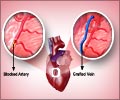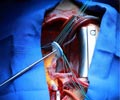- Mitral valve regurgitation - (http://www.nlm.nih.gov/medlineplus/ency/article/000176.htm)
- Heart & Vascular Institute (Miller Family) - (http://www.clevelandclinic.org/heartcenter/pub/guide/disease/valve/mvrepairfaq.htm)
- Congenital Mitral Stenosis With or Without Associated Defects - (http://circ.ahajournals.org/cgi/content/full/102/suppl_3/iii-166)
- Mitral Stenosis - (http://www.emedicine.com/med/topic1486.htm)
- Hospitalization statistics for Mitral valve disease: - (http://www.wrongdiagnosis.com/m/mitral_valve_disease/stats.htm#medical_stats)
- Congenital Mitral Stenosis - (http://www.emedicine.com/ped/topic2517.htm)
About Mitral Valve Replacement
Mitral valve replacement is replacing the diseased mitral valve with an artificial valve.
Mitral valve replacement is a surgical heart procedure to correct either the narrowing (stenosis) or the leakage (regurgitation). The surgery requires opening the chest and is performed by a specialist called ‘cardiothoracic surgeon’.
The Mitral valve has two flaps or leaves that work as a one way "inflow valve" for the left side of the heart. The valves are normally very robust, cause no problems, lasts a lifetime and generates 3 billion heartbeats in its lifespan.
The heart works like a pump and as it constantly beats, it carries oxygen and nutrients to all our 10 trillion body cells. Each day our blood travels 60,000 miles (or 96,000 Kilometers) through the big and small vessels in the body. It pumps over 2,000 gallons (i.e. approx 7,600 liters) of blood. To handle this load the four valves of the heart have to function very efficiently. A narrow valve or a leaking valve can play havoc with the function of many organs of the body.
In India, rheumatic fever is a major problem in children and young adults. It is one of the leading causes for mitral valve disease in developing countries. Every 2-11 per 1000 children develops rheumatic heart failure in our country. Preventing rheumatic heart disease by promptly treating rheumatic fever is essential. In the western countries, Mitral valve prolapse has replaced rheumatic fever as the leading cause of Mitral valve disease.
Mitral valve disease due to small stenosis or regurgitating valve may not require surgery and more so if the patient is asymptomatic.
Heart lung machine used in open-heart surgeries were developed in 1950s. About a decade later, it was possible for surgeons to perform the first mitral valve replacement. Up to 1980s, the only surgical option for patients with mitral disease was a replacement but all this changed when a French surgeon, Alain Carpentier published a paper on Mitral Valve repair. Since then, repair is predominantly done for mitral valve disease. Replacement is needed on patients with severe damage to the valve structures. Mitral Valve repair can be done through an angiogram approach or by an open-heart surgery. Repair usually involves removal of excess tissue or reshaping the valve.
Patients usually have no symptoms after mitral valve replacement. The artificial valves, especially mechanical, lasts a lifetime. The two main disadvantages of mitral valve replacement are infection and the need to give patients blood thinners for lifetime. Both can cause life-threatening complications; hence monitoring and regular follow up is a must after the surgery. Instead of mechanical valves tissue valves form a donor can be used. But the downside is that they may not last a lifetime and may need replacement after 10 to 15 years.
Isolated Mitral valve replacement can take approximately 3-5 hours.
Hospital Stay is about 7-10 days.
















Methods for Mitral Valve Repair: Annuloplasty:In annuloplasty an artificial ring is placed around the annulus of the valve.This ring reinforces the annulus and restores the valve to its normal shape and size. Balloon Valvuloplasty:Balloon valvuloplasty is performed using a catheter, i.e. a very thin flexible tube which can be inserted into the body, with a balloon at the end. The balloon is put inside the valve and is expanded thus stretching the valve and bringing it back to its normal size. For more info: heart-consult.com/articles
Various symptoms are
* Shortness of breath.
* Pulmonary edema or fluid accumulation in the lungs.
* Orthopnea or shortness of breath while lying flat.
* Paroxysmal nocturnal dyspnea or Cardiac Asthma
* Decreased exercise tolerance.
* Swollen feet or ankles.